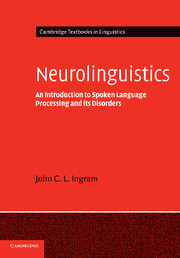Book contents
- Frontmatter
- Contents
- List of figures
- List of tables
- Preface and acknowledgements
- Note on the text
- Part I Foundational concepts and issues
- Part II Speech perception and auditory processing
- 5 The problem of speech recognition
- 6 Speech perception: paradigms and findings
- 7 The speech recognition lexicon
- 8 Disorders of auditory processing
- Part III Lexical semantics
- Part IV Sentence comprehension
- Part V Discourse: language comprehension in context
- Glossary
- References
- Index
7 - The speech recognition lexicon
Published online by Cambridge University Press: 26 January 2010
- Frontmatter
- Contents
- List of figures
- List of tables
- Preface and acknowledgements
- Note on the text
- Part I Foundational concepts and issues
- Part II Speech perception and auditory processing
- 5 The problem of speech recognition
- 6 Speech perception: paradigms and findings
- 7 The speech recognition lexicon
- 8 Disorders of auditory processing
- Part III Lexical semantics
- Part IV Sentence comprehension
- Part V Discourse: language comprehension in context
- Glossary
- References
- Index
Summary
Introduction
Thus far, we have not entirely neglected but certainly down-played the role of the lexicon in speech perception. In chapters 5 and 6 we sought to make a case that speech recognizers must be able to build phonological representations of possible word forms, purely on the basis of acoustic phonetic input. Otherwise, it is difficult to account for the robustness and flexibility of our ‘bottom-up’ speech recognition capabilities. But it is also true that the goal of speech recognition is to identify words in the service of understanding whole utterances, and that there are a host of ‘top-down’ lexical, semantic and discourse effects that arise as a consequence of lexical retrieval mechanisms. Such effects express themselves in (a) the different ways that we respond perceptually to words (e.g. kelp) versus non-words (whether pronounceable like klep – a possible word – or phonotactically illegal, like tlep), (b) neighbourhood effects, arising from the fact that particular words vary in the number of phonologically near neighbours that compete for matching to the acoustic signal, and (c) other effects, such as phoneme restoration (see below), which may or may not be lexical in origin, but nevertheless require explanation.
The account given in previous chapters has characterized speech perception as an active process whereby phonological forms are constructed from speech-specific (phonetic) features in the acoustic signal, via the application of specialized perceptual analysers that exploit tacit knowledge of the sound pattern of the language and the sound production constraints of the human vocal tract.
- Type
- Chapter
- Information
- NeurolinguisticsAn Introduction to Spoken Language Processing and its Disorders, pp. 140 - 154Publisher: Cambridge University PressPrint publication year: 2007



